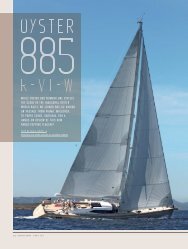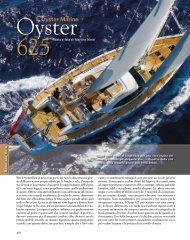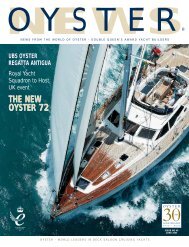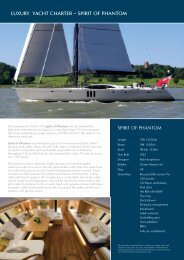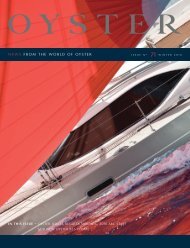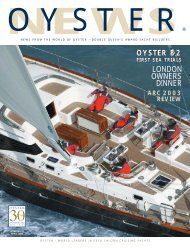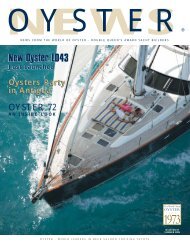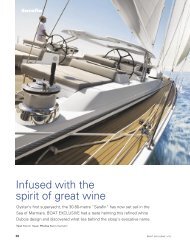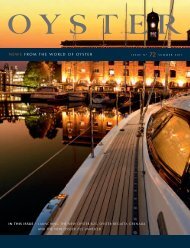Download PDF - Oyster News 66 - Oyster Yachts
Download PDF - Oyster News 66 - Oyster Yachts
Download PDF - Oyster News 66 - Oyster Yachts
Create successful ePaper yourself
Turn your PDF publications into a flip-book with our unique Google optimized e-Paper software.
We had our first experience drinking kava shortly after arriving in Fiji. We joined a<br />
local man sitting on a woven pandama mat, crossed our legs yoga style in front of<br />
a four legged wooden kava bowl and threw back a coconut shell filled with a muddy<br />
looking mixture that immediately numbed our tongues and throat.<br />
Not many years ago the kava would have<br />
been drunk from the skull of an enemy<br />
and the roots of the kava pepper plant<br />
chewed by young women who spat the<br />
grounded root into a wooden bowl for the<br />
consumption of male village elders.<br />
We had arrived in Fiji a few days before<br />
with the Blue Water Rally whom we had<br />
joined in Panama. We tied to a mooring<br />
at the Copra Shed Marina on the island<br />
of Vanu Levu, the more remote of the two<br />
larger Fijian islands. There are fewer<br />
tourists on Vanua Levu than on Viti Levu<br />
and the streets of Savu Savu were busy<br />
with local activity. Indo Fijians are the<br />
foundation of the country’s economy,<br />
operating small businesses and stores,<br />
growing produce and offering it for sale<br />
in a large covered market where we<br />
purchased the customary gift of kava root<br />
to offer to the chiefs of villages that we<br />
planned to visit.<br />
Fijian natives on the other hand prefer<br />
to live in villages along the coast<br />
independent of others except for the<br />
purchase of basic staples and every day<br />
the sidewalk outside the bus stop would<br />
include an array of colourful ankle length<br />
dresses as native women waited to be<br />
transported back to their villages.<br />
A former secluded village located 20 km<br />
outside Suva Suva had recently decided to<br />
experiment in the tourist trade with guided<br />
tours to one of their most sacred of sacred<br />
commodities, the Red Prawns. Red Prawns<br />
are one of Fiji’s endemic species, a rare<br />
shrimp that appear pink in colour before<br />
cooking. They are found in two locations in<br />
Fiji and have probably survived throughout<br />
the centuries due to the fact that native<br />
Fijians declare them sacred and claim<br />
those who attempt to remove them will fall<br />
prey to the evils of the sea.<br />
A hike over aging bridges, through mango<br />
swamps, salt water pools, overgrown<br />
vegetation and a 500 metre salt water<br />
channel, mid calf deep with low tide, lead<br />
us to an islet. We lowered ourselves down<br />
a shallow rock face to a small cave where<br />
the red prawns often take refuse until a<br />
gifted member of the Narwani clan sings a<br />
solemn calling song summoning them into<br />
the open lava rock pool. Traditionally,<br />
gifted natives call for sea turtles, sharks<br />
and other sea life during practiced rituals.<br />
We left Suva Suva to join our Blue Water<br />
Rally friends on Malolo Leilei Island located<br />
in the Mamanuca Islands about 15 km<br />
west of the large island of Viti Levu.<br />
The group of twenty islands, mostly of<br />
volcanic origin and now blanketed in<br />
greenery amidst crystal turquoise waters,<br />
sit on the North Western limit of Fiji and<br />
are exposed to open sea allowing a north<br />
swell to ruin a night’s sleep if you do not<br />
tuck into a protected bay.<br />
Musket Cove, located inside the barrier reef,<br />
is one of the safest and most sheltered bays<br />
in the Mamanuca’s and sits amongst several<br />
smaller reefs lying incognito like land mines<br />
in an unsuspecting field.<br />
In the approach to Malolo Island, we sailed<br />
within close proximity of several<br />
surrounding islands watching waves break<br />
over an assortment of reefs while our<br />
charts indicated there were far more coral<br />
impediments than what we could visualize.<br />
Amongst the small islands there are few<br />
international navigational markers and we<br />
found only current mangled, windblown<br />
naked sticks lying at an assortment of<br />
angles, some adorned with bundles of<br />
upright branches with a sort of army<br />
brush-cut appearance. We learned later,<br />
the upside down bristle broom look were<br />
taboo markers erected by natives<br />
indicating areas of native fishing rights.<br />
There’s not much chance anyone would<br />
try to approach Musket Cove after sunset,<br />
not even the Malolo ferry runs after dark,<br />
but if you did attempt it, using the present<br />
navigational leading lights you would find<br />
yourself high and dry on the sandy<br />
extremity of Malolo Leilei Island, as the<br />
lights were reportedly never installed in<br />
proper alignment. Well I guess all would<br />
not be for lost, as you would be beached<br />
only metres from the Four Dollar Bar.<br />
Moorings are available outside Musket<br />
Cove as an alternative to tying to dock<br />
inside the cove or hanging out for the<br />
arrival of high tide in order to navigate ><br />
LEFT: Anchored alongside a fellow <strong>Oyster</strong> in Musket Cove<br />
ABOVE: One of the village children, Namara<br />
OWNER REPORT<br />
www.oystermarine.com 47






